As an Amazon Associate I earn from qualifying purchases.
Anyone who has ever served wild game to someone unfamiliar with it has probably heard them say something like, “This is… gamey.” So-called gamey meat is the bane of a hunter’s existence, but putting your finger on what is and is not gamey is no easy task.
There are two sources for gaminess in meat: Unfamiliar flavors, and meat that is tainted or otherwise “off.” I’ll go into both here.
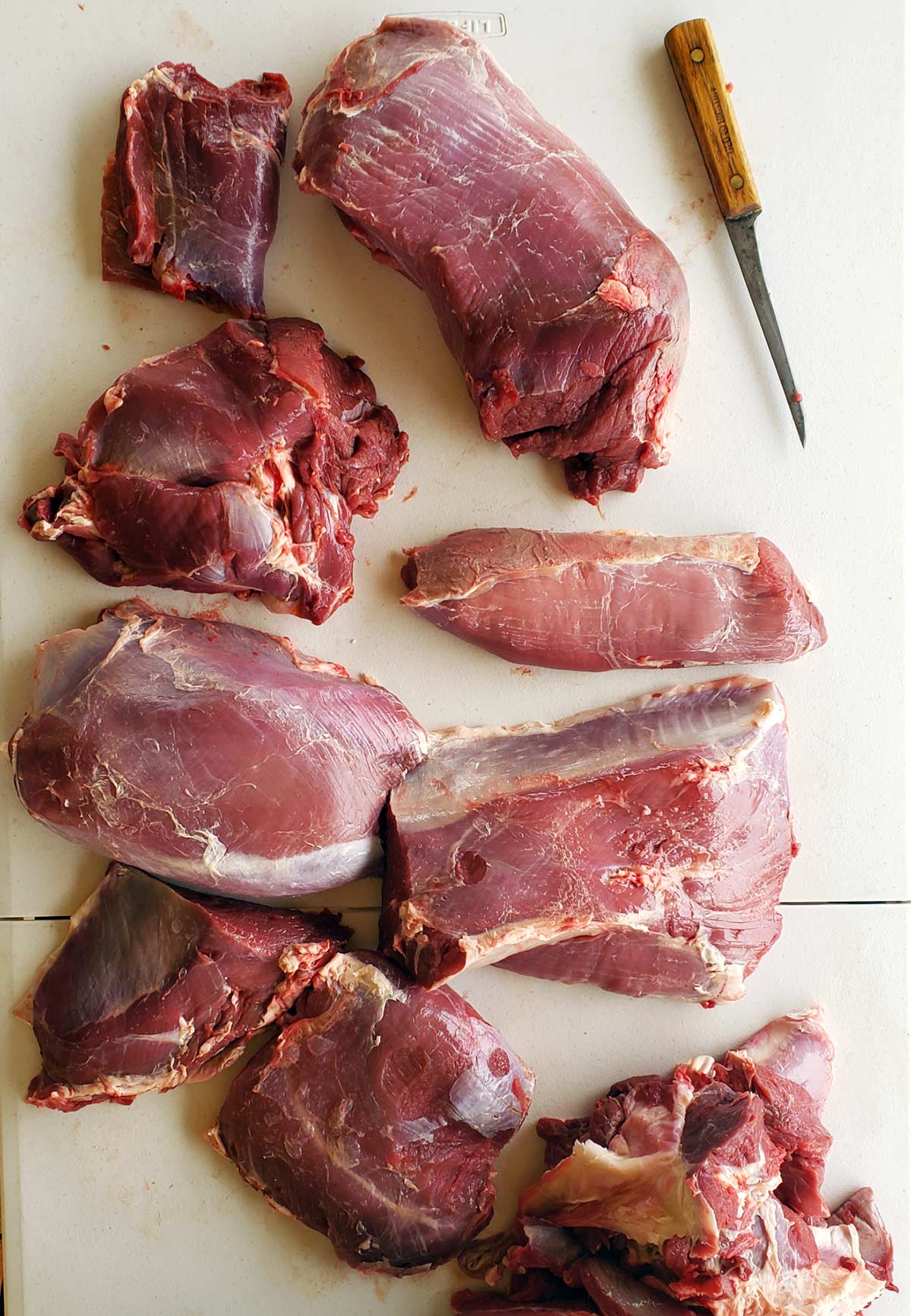
First and foremost, gamey meat is, well, game. Hunted meat. Mostly. Several farmed animals, notably lamb (mutton), older goats and guinea hens can also be perceived as gamey.
That said, over the decades, I have heard pretty much everything called gamey, even rabbit and quail, which I think are the mildest of all meats. I once heard a contestant on the TV show “Top Chef” extoll the flavor of farmed quail because of how gamey it is. Uh… dude. Farmed quail is so flavorless and mild, it’s the closest thing to Soylent Green I’ve had other than maybe tilapia.
At its core, gamey meat means meat that tastes differently from standard, store-bought, farmed meats. It is neither good nor bad, although I’ll get to cases where is it most definitely bad.
But what causes gaminess? Several reasons, starting with the nice ones.
Diet
This is the primary reason. Supermarket meats are fed almost entirely on corn. And corn lends a specific flavor to meats, one we now regard as standard. It is a bland, approachable flavor. Fat from corn-fed animals is firmer and more saturated than those eating most other things, notably nuts or grass. You can see this clearly in pork. Corn finished pork fat is strikingly harder and milder than fat from hogs finished on nuts.
For the most part, wild animals eat things other than corn. And yes, I know there are lots of wild animals that do eat corn, notably whitetail deer, ducks, geese, pheasants and hogs. But even these animals don’t subsist entirely on corn, which is why a pheasant doesn’t taste like a chicken, even though they are cousins.
(All about the intricacies of wild game fat, and why you might want to hunt specifically for it, are in this article.)
Gamey meat is almost entirely a function of the flavors in skin and fat. Most of the stronger aromas we perceive in meat are fat soluble and reside in that fat. A prime example is in waterfowl. A scoter eats mostly clams, and its fat is pretty nasty (to most people). But if you skin this bird, its meat is not terribly different from that of a similarly skinned mallard. Ditto for spoonies, the northern shoveler.
Most striking, at least to me, are ptarmigan and spruce grouse. These birds’ diet of berries, forbs, lichen and conifer needles makes them the most pungent and powerful of all game birds. You either like them or not, but gamey they are most definitely.
For big game, I’ve noticed that the diet of a Coues deer, a little subspecies of whitetail that lives in the Desert Southwest, alters its fat enough to where it does not coat your mouth the way fat from a grain-fed whitetail in, say, Illinois would. I’ve had very sagey mule deer, and mild ones. It’s the fat.
(I have a whole article on the complexities of deer fat here.)
And if you manage to remove all the fat from a slab of mutton, it will be much more mild than one with its fat cap. Interestingly, one main reason lamb is thought of as gamey is because of all our domesticated meats, lamb is the one most often raised entirely on grass. Only Colorado lamb is commonly finished on grain.
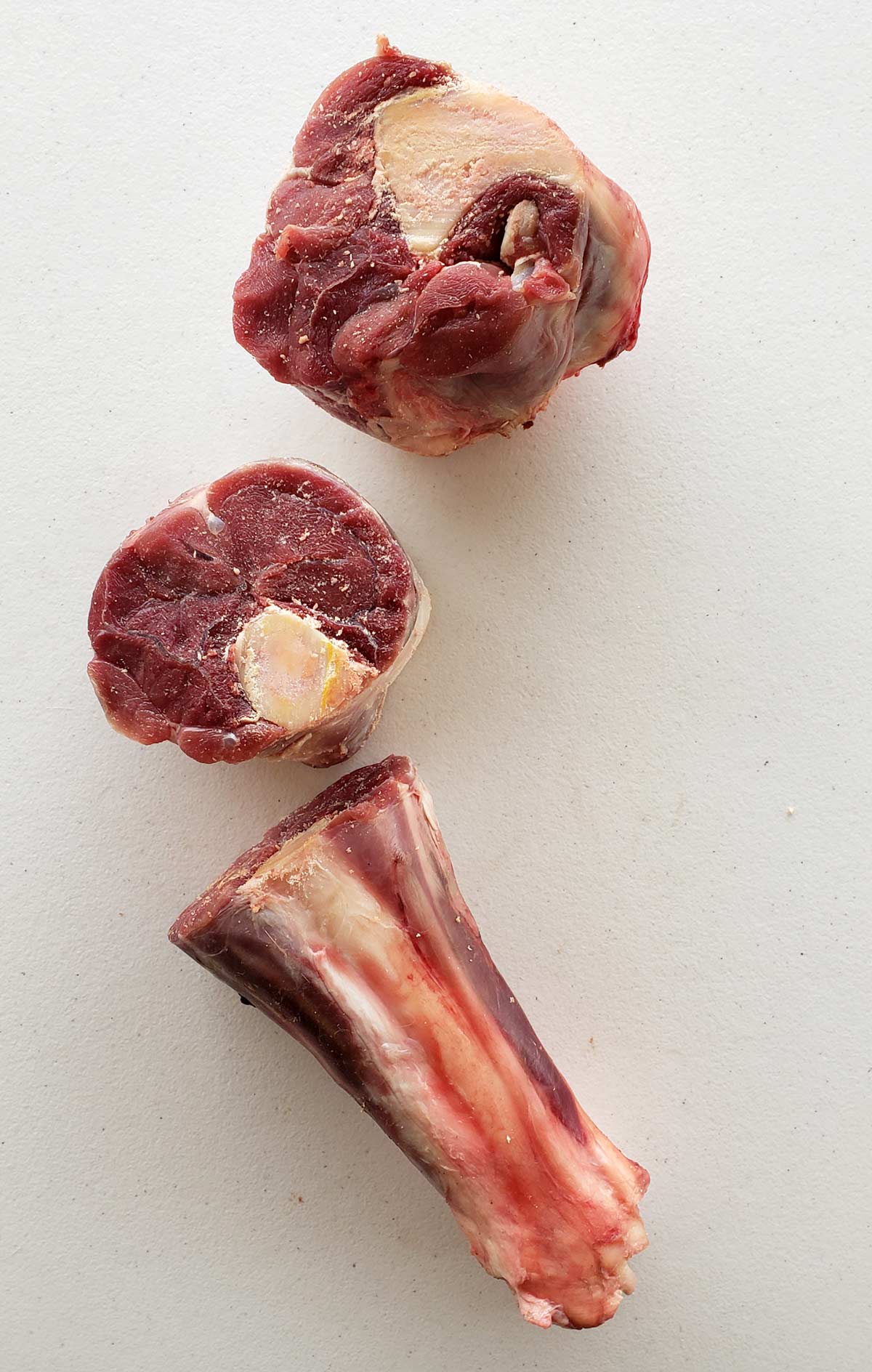
Older Athletes
A second, important reason for so-called gamey meat is the fact that wild animals are older and are far more athletic than their domesticated counterparts.
Typically, hunters bring home deer that are several years old, and elk, bear and moose can push 10 years old or more. Most birds killed by hunters are young of the year, but waterfowl can live beyond 30 years old, and five-year-old turkeys are not impossible.
And even young-of-the-year birds are typically older than their domestic cousins. A fryer chicken can be as little as five weeks old. No quail, pheasant, partridge or duck is that young. In fact, the youngest wild animal we commonly hunt is a dove. In some rare cases, month-old doves can be shot in warm places, where their parents raise up to six broods a year.
Furthermore, even young-of-the-year game animals work for a living. Their tendons are stronger, their meat is denser, and they are normally far leaner than their couch potato relatives in the barnyard. All of this has an effect on flavor.
Now consider an old Canada goose, which can be up to 30 years old. Its flavor will be radically different from a five-month old domestic goose, and even the youngest wild goose will be six months old.
In all these contexts, “gamey meat” equals meat with character, with depth, and with flavor wholly of itself.
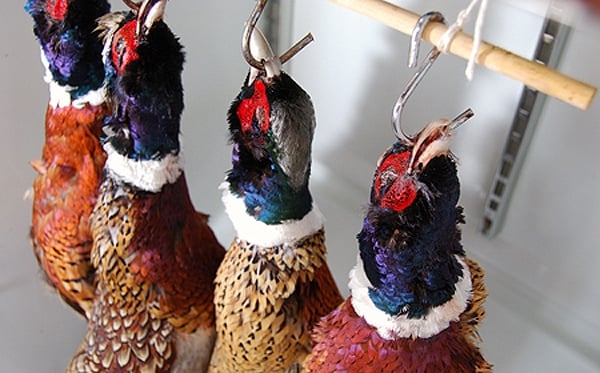
Aged Meat is Gamey
Now we should talk about aged meat. Simply put, aged meat is gamey. To most, in a good way. To the uninitiated, it can be an overwhelming experience.
Let’s start with aged beef, because that’s what most of us have experience with… except I am betting that you haven’t, because true, real aged beef is at least three weeks old, and you don’t really get into the kaleidoscopic world of aged beef flavors until you cross a month.
Really well-aged beef shares a lot, flavorwise, with blue cheese. It’s stinky in an oddly attractive way, and ultra tender. No teeth needed.
All of this can apply to wild game, too. You can certainly dry age venison for a month, and it will start to take on some of those richer, more savory, almost cheesy tones. Venison won’t get as cheesy as beef because it lacks internal fat, but it will change, profoundly, if properly aged. (Read my detailed tutorial on dry aging meat – even without a fancy dry ager – here.)
Birds are famous for this. A well-aged pheasant is a wondrous thing. A fresh pheasant is a boring chicken.
(I have an entire guide to hanging pheasants and other game birds here.)
In fact, the process of hanging, aging game birds is called faisandage in French, after their word for pheasant, which is faisan. In English it’s called mortification. This combination of bacterial and enzymatic action on meat intensifies flavor and aroma and umami.
Done well, it is the pinnacle of wild game flavor. And it is most definitely gamey meat. In a good way.
Bad Gamey
OK, now we need to talk about gamey meat in a bad way. Because it’s real.
Most of us have had wild game that is, well… off. Twangy. Sour. Smelly. Not sexy-musky — rotten, pungent, attack-the-nostrils stinky. I’ve most often encountered this with big game, usually some sort of cervid like a deer or elk, and, very commonly, pronghorn.
This sort of gamey meat is, usually, all about poor hygiene and meat handling. This is the hallmark of a mistake, or, more likely, several mistakes.
Allow me to use the much maligned pronghorn as an example. Historically, pronghorn are hunted in early fall by multiple hunters. This is a generalization, but I’ve seen it many, many times. Let’s say there are five of us. Most of us shoot our speed goat early in the morning, but Poor Guy Five can’t seem to buy a break. He misses one, maybe two, and doesn’t connect on his until, say, 3 o’clock in the afternoon.
Only now do we all start gutting and skinning our animals. Poor Guy Five’s pronghorn will be nice, but everyone else’s will be ruined. Even if we’d all gutted our antelope as we’d shot them, it’d still be a mess because the skin on a pronghorn holds heat better than that of a deer, and you are often hunting in 75°F weather.
Similarly, waterfowl are often so fat they retain enough heat that if you don’t chill them down, if you are hunting in warm weather they can go off in the course of an afternoon.
And with large animals, like moose, if you don’t cool them down ASAP, there’s a condition called bone sour that can ruin the whole animal. But imagine if this was your hunt of a lifetime? You’re going to take that meat anyway. But you better believe it will be some seriously gamey meat.
Bad bacteria really enjoy temperatures over 60°F, and with red meat, anything much over 40°F for any length of time means trouble.
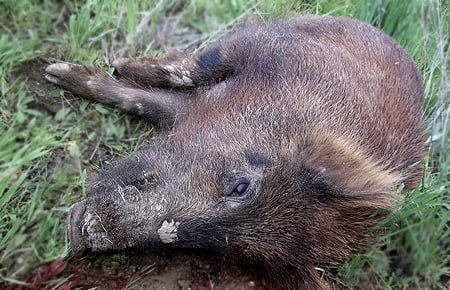
There is another big source of bad gaminess in meat: Hormones. This is almost exclusively with mammals.
Anyone who has shot a big ole’ boar hog, or a huge, rutty buck, knows what I am talking about. The testosterone in these animals stinks, and taints the meat. Now don’t get me wrong, it’s still edible, but there is a noticeable flavor and aroma to a testosterone-soaked animal. Holly says she knows when I am cooking a male pig, and her guess is almost never wrong.
Hormones in rutting bucks and bulls affect flavor, too. In addition, a rutting animal will lose weight and fat, and will be fighting constantly, stressing muscles and increasing the potential for old wounds in the meat, caused by sparring.
Finally, how you kill the animal matters. A stressed animal’s meat will never be as good as one that was not stressed. This too is because of hormones. The meat industry goes to great lengths to design its killing facilities in such a way as to not stress the animals — not so much for humane slaughter as for meat quality.
So the next time you “shot a little far back,” and wondered why your meat was gamey, that could be why. Needless to say shooting a fleeing animals falls into this, too.
Taming Gamey Meats
I’ll be honest: There’s not a lot to do about truly gnarly, gamey meat. I mean, I once make about 50 pounds of Mexican chorizo from a boar, but it still had a twang of ‘nads on a hot day.
That said, you can remove the gamey taste of game in several ways. First is to brine it in a solution of 1/4 cup kosher salt to 1 quart water overnight; that’s the ratio, since you will often need more than a quart.
A second method is to soak meat in milk in the fridge overnight. I will often do this to kidneys and livers of big game animals, which can be off-puttingly smelly without this treatment.
A red wine soak is a good call, too — if you are planning to cook your meat in a stew or somesuch. One important tip: Boil the wine first, then cool. If you don’t do this, you will get a weird, metallic flavor that I believe comes from the alcohol, which is burned off by the boil. You can soak gamey meat in pre-boiled red wine for several days in the fridge.
Finally, practicing good meat care is an obvious one, as is being careful to not cut things like tarsal glands in deer or the scent gland in a javelina. Also, ice is your friend. Cold meat equals good meat.


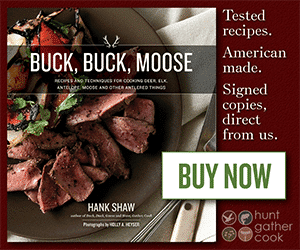





Hamburger is my agitation. Sometimes it has a wonderful aroma and taste, other times it smells pretty good but has the gamey taste that ruins it, it changes the taste far away from what a good hamburger should taste like. If you go to Five Guys you get the aroma and taste that is what I think to be wonderful, sometimes we get that at home with grocery store 80/20 hamburger but not regularly. How can I ensure getting the non-gamey taste in my hamburger?
A ruminant should be field dressed immediately. The stomach is basically a fermentation chamber. This is why the belly of a deer starts to swell soon after being killed – the contents of the stomachs are fermenting. With time and pressure, the gas created starts to flow through the vein and arteries and into the meat which can taint the meat.
I always try to be gutting the deer within 30 minutes of shooting it, normally 15 minutes….
When the animal’s heart stops beating blood stops flowing. That blood no longer carries away the lactic acid that is building up in the muscles. Cells continue to live, consume carbs (blood sugar) and process lactic acid as the by product. With no circulation, lactic acid builds up (rigor) and the ph drops in your meat. I hate open season hunting – we can always get a warm spell in Nov/Dec which means I need bags and bags of ice to cool down my kill. I much prefer our LOP (and cow only) hunting gains. There is likely snow on the ground that I can stuff her with in the field to cool her down quickly. Also ice cold water to wash her down with after we skin her, before the hang. Yes ice, snow, cold water, cold weather are truly friends of the meat ph … while maybe not so much for me 😉 Ice and whiskey are my friends…
In case you’ve never heard of it,,, there’s a way to sour all meat and fish that uses uncooked but crushed rice, salt, and water.
I’ve had fish, port, elk, and beef done that way but I guess any meat will do. Not to be confused with fully fermented fish that sits in a clay pot for a year popular throughout SEAsia. You squeeze the rice/water/salt mixture into the meat a little, make sure there is enough water to cover the meat, and put it in a jar on the counter at room temp. After a couple or three days it’s usually close to done, test by cooking a small piece. Smell helps too. It should be sour, not rotten.
Mustard greens are also done similarly, and cabbage with thin slice pig ear.
The name for all these things in Laotian begins with “some” the word sour. som pak=sour vegetables, som moo=sour pig, etc. Good way for folks without a fridge to extend the life of meat for a few days.
I always heard larger boars taste bad for the reasons you mentioned in your article (testosterone, age… etc.).
I recently took down a 300-350lbs boar. When I was processing it, I only kept the meat I thought would be best – mainly the hams, shoulders, back straps and tenderloins. I tossed a bunch of the fattier meat.
I’m kicking myself now because it is some of the best game meat I’ve ever had. It taste like a cross between pork and beef with no gaminess at all.
Any thoughts on why this pig taste so good? What makes one of these big hogs taste bad vs good? What to look for, to know if the meat will be good or bad when processing?
I’ve got some gamey (rutty) caribou that my hunting partner and I harvested. He couldn’t stand the taste, so now I have it all. I’ve tried using your chili recipe (which did vastly improve it) as well as a salt water soak and a milk soak. Neither of those drastically impacted the taste (although the milk did improve it a bit). Any recipe suggestions?
I should add that it’s not so bad that I wont eat it, but I wouldn’t share it with friends.
Excellent comments. A secret I’ve learned from South Georgia dove hunters also works for old Canadian goose:
Remove the breast, cut 3 small incisions on each side of the breast.
chop a white onion into small pieces
Chop a pickled (Trappley) jalapeno pepper into small pieces
Alternate inserting onion and jalapeno in a incision, respectively
Wrap the breast in bacon fastened by toothpick, and cook over BBQ grill or pan in broiler until the bacon is done. The meat should be on the rare side — do not overcook.
Excellent “finger food” or final dish. No gamey flavor, goose tastes like tenderloin.
Cut the goose breast into 1 inch wide strips, insert onion and jalapeno into slits, wrap in bacon and proceed with grill or broiling.
Bernard Wolff
I would add that long term stressed animals are depleted on energy reserves in their muscle cells – the ATP.
This disrupts the rigor mortis process and desired pH value after rigor mortis is too high. There are multiple bad side effects from this such as poor water retention (dry meat), impossible to age it with the same success as a non-stressed animal and a meat that is easier to spoil due tot the higher pH is a friendlier environment to bacteria.
There are probably more bad side effects as well that can be contributed to the energy aspect due to stress rather than the hormone aspect that I can’t recall at the moment
Kjell: Excellent point.
Very well said. Hank is a plethora of knowledge. Thank you for doing what you do!
When I first started hunting ruffed grouse I used to carry them around until the end of the hunt. I thought ruffed grouse were gamey. Then I started skinning and breaking them down on the spot and suddenly they weren’t ‘gamey’ anymore. Seems they just spoil really fast, even in cool fall weather. Admittedly, done this way the breasts can pass for chicken, but it could be worse.
Another thing I found with them is that like a lot of things, letting them sit in the fridge for a week makes a tremendous difference in terms of tenderness.
I get a deer almost every year, including a few mature late November, rutted out bucks, and I have never had one that tasted ‘gamey.’ But like with the grouse, I typically break them down in the woods right away, then keep them cool (in a big cooler for the deer) for a week plus before butchering.
Hi Hank,
Great article. Interesting and informative – and I’m still chuckling over “twang of ‘nads.”
A friend gifted me some muley from Colorado, butchered at a processor. The straight cuts are delicious, but the ground meat is gamey enough to gag me a bit. I’m wondering if his deer was ground with other funky ones?
As always, thanks for doing what you do and sharing your knowledge.
not Hank, but the only nasty gamey meat I’ve had was from a WY muley, the same thing – backstrap etc was good, ground meat was let us say very powerfully flavored.. We cleaned and cooled that animal within an hour, my son dropped it stone dead with a single shot as it grazed, so dunno where any gaminess came from. Maybe as you say, it got ground up with someone else’s unhappily-hunted beast..
A pronghorn from WY, had a mild sage flavor that was quite delicious.. we used a different processor for that meat.
I would have to be blood brothers with butcher to trust him with my game, cutting and grinding your own meat is a joy. Hard work that will make you appreciate each meal. I had to do it, like so many on a trip to Alaska. The first we had them cut and wrap our caribou. It was awful, and we took real care of our quarter’s, covering with sleeping bags and putting in shade in the day and uncovering at night. The next trip we broke down the muscles, donated the grind of both moose and caribou, and had them bagged, boxed and flew them out. After cutting and wrapping our self it was delicious. Now a day’s we pick-up hunt out of state…all about the meat. Thanks Hank for all your great recipes
Typically there is more fat from the animal included in the grind meat, especially if they didn’t do much trimming. Whereas whole muscle cuts like back straps, hind quarter roasts etc have very little fat. As hank said, typically the strongest “gamey” flavors come from the fat, so that would be my guess as to why there is a difference: more deer fat in the ground meat.
Great article Hank. I can see myself sharing this many times going forward with friends and strangers on the internet. Still getting myself more mentally comfortable with hanging birds, since I don’t hunt them too much, I’m always concerned about a hidden pellet in the gut marinating. I guess that’s the big game hunter in me and wanting to gut immediately.
a tip you can layer sliced onion on roasted meat. it will take out most gamey meat flavor .
While roasting or after?
Wow. Excellent article. Thanks for pulling together a comprehensive overview of this important topic. I host workshops on meat care in the and field butchering for new hunters. This would be essential pre-reading for student. Can I direct student back here as part of the course content? I have been really enjoying the regular recipe posts. Been keeping me inspired to cook everyday through this crazy time. Thanks Hank!
Excellent piece that does justice to game meat and is a service to hunters and their guests at table. Much appreciated!
Hank, just a little information. Colorado is not the only region grain feeding lambs. A large % perhaps the majority of lamb slaughtered in the US is grainfed.
Evans: Interesting. I guess I have old information. Twenty years ago, Colorado lamb was the only major lamb producer to grain finish.
What about “gamey-ness” that is more along the lines of “liver-y” flavored? Could this be related to how the animal was bleed?
YES, that’s what my doe tastes like, liver. I don’t want to eat it!
Spot on, as always. Hank, you inspired me to start aging beyond 7 days about 5 years ago, and last year I did two deer in my shop refrigerator at 33-34 degrees F for 25 days. I shot one in late October, the second in early November, both field dressed, hosed out and iced down immediately. After skinning and basic breaking I put the backstraps in polycarbonate brining/Marinating bins from the restaurant supply. I covered the quarters loosely with clear plastic bags, with cold air between the meat and bags. Only a nice clean meaty smell after 25 days, no lost “rind” meat, no struggling the skin off when you hang skin-on for 25 days. What’s your opinion about this method? Taste on both the doe and the buck have been “wunnerful” as my Dad used to say.
Yes, we raise (100% grass fed pastured) sheep. There is a SIGNIFICANT difference in the gameyness of males over 6 months old, slaughtered in breeding months (Oct-March) vs the rest of the year. Even older males can taste non-gamey (hormonally), if slaughtered in June, quickly and quietly. The grass fed flavor always remains though. It’s a really nice flavor though. I would not call it “gamey”. It’s hearty.
Tuffy: Good to know about when to properly slaughter mutton! I did not know that.
Hank, great article! My brother in law taught me years ago to soak in whole milk overnight, he also taught me to cook blackstrap in a combination of 1/3 butter, 1/3 bacon fat and 1/3 olive oil. I do not know scientifically the whys of what makes it work but I can absolutely attest to not one piece of deer I have ever cooked ever tasted anything but absolutely delicious. I taught my husband 40 years ago how to cook it. I told him this is going to be really fast…..he overcooked several pieces before he realized I meant slap that on the cast iron, flip it over and move it to the platter fast. Even the overcooked pieces were slap your momma good. If you knew my momma, you would know you were taking your life in your hands if you ever slapped her…for real… she raised 8 kids and 4 were my daddy’s and 4 were hers. She was military strict and when she said something, she wasn’t joking. We grew up hunting, fishing to feed 10 people in our house and nothing went to waste. We raised chickens and knew exactly what to do when it was time to butcher them. I must say I have 2 chickens and 3 ducks including a wild Indian Runner who adopted us and won’t be butchering any of them. But I do love those 2 chicken and 3 duck eggs I get daily! Thank you to everyone who had posted your comments for the information in your posts!